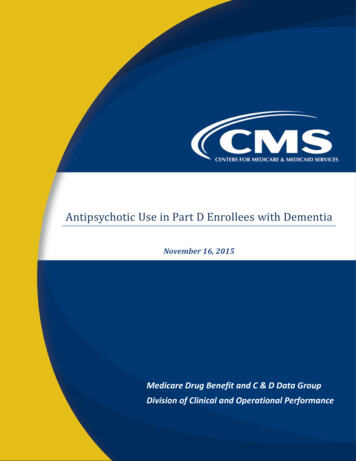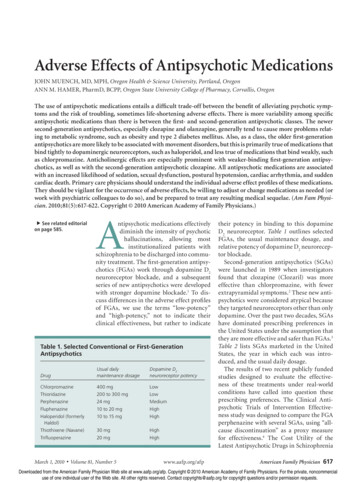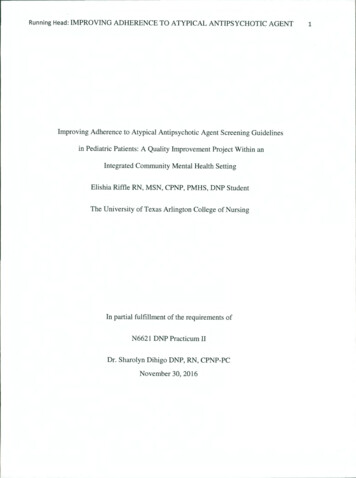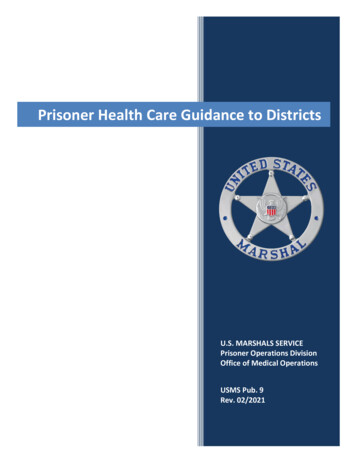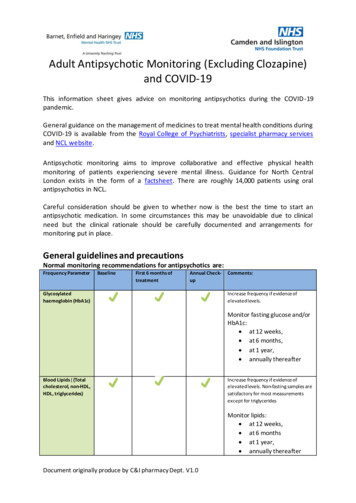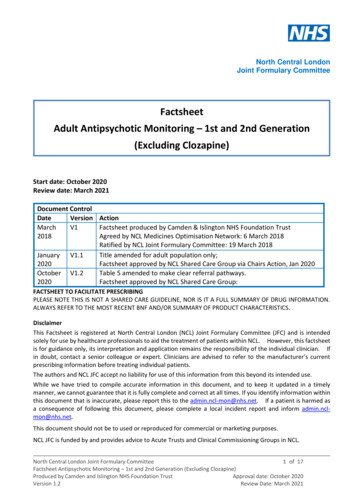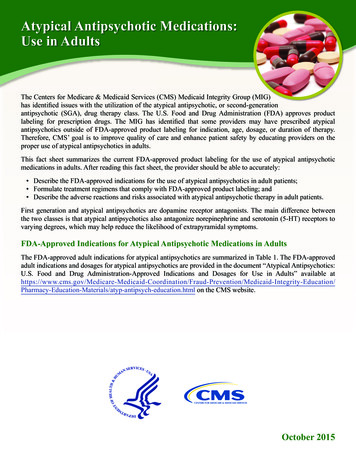
Transcription
Atypical Antipsychotic Medications:Use in AdultsThe Centers for Medicare & Medicaid Services (CMS) Medicaid Integrity Group (MIG)has identified issues with the utilization of the atypical antipsychotic, or second-generationantipsychotic (SGA), drug therapy class. The U.S. Food and Drug Administration (FDA) approves productlabeling for prescription drugs. The MIG has identified that some providers may have prescribed atypicalantipsychotics outside of FDA-approved product labeling for indication, age, dosage, or duration of therapy.Therefore, CMS’ goal is to improve quality of care and enhance patient safety by educating providers on theproper use of atypical antipsychotics in adults.This fact sheet summarizes the current FDA-approved product labeling for the use of atypical antipsychoticmedications in adults. After reading this fact sheet, the provider should be able to accurately: Describe the FDA-approved indications for the use of atypical antipsychotics in adult patients; Formulate treatment regimens that comply with FDA-approved product labeling; and Describe the adverse reactions and risks associated with atypical antipsychotic therapy in adult patients.First generation and atypical antipsychotics are dopamine receptor antagonists. The main difference betweenthe two classes is that atypical antipsychotics also antagonize norepinephrine and serotonin (5-HT) receptors tovarying degrees, which may help reduce the likelihood of extrapyramidal symptoms.FDA-Approved Indications for Atypical Antipsychotic Medications in AdultsThe FDA-approved adult indications for atypical antipsychotics are summarized in Table 1. The FDA-approvedadult indications and dosages for atypical antipsychotics are provided in the document “Atypical Antipsychotics:U.S. Food and Drug Administration-Approved Indications and Dosages for Use in Adults” available on.html on the CMS website.October 2015
Table 1. FDA-Approved Adult Indications for Atypical AntipsychoticsIndicationsbipolar I disorderbipolar depressionschizophreniaschizoaffective disordermajor depressivedisorder (MDD), adjunctAtypical Antipsychoticsaripiprazole,[1, 2] asenapine,[3] olanzapine,[4] quetiapine,[5]quetiapine extended-release (XR),[6]risperidone,[7] ziprasidone[8]lurasidone,[9] olanzapine, quetiapine, quetiapine XRaripiprazole, asenapine, brexpiprazole,[10] clozapine,[11, 12]clozapine oral suspension,[13] iloperidone,[14] lurasidone,olanzapine, paliperidone,[15] quetiapine, quetiapine XR,risperidone, ziprasidoneclozapine, paliperidonearipiprazole (Abilify ), brexpiprazole, olanzapine, quetiapine XRTreatment Guidelines for the Use of Atypical Antipsychotics in AdultsThe Agency for Healthcare Research and Quality (AHRQ) hosts a database of treatment guidelines. The AHRQis a branch of the U.S. Department of Health and Human Services. For information on the available treatmentguidelines, search “atypical antipsychotics” or any of the conditions for which an atypical antipsychotic isan indicated treatment in the AHRQ’s National Guideline Clearinghouse at https://www.guideline.gov on theInternet. Links to some of the guidelines that provide information on the use of atypical antipsychotics in adultsare provided in Table 2.Table 2. Treatment Guidelines for the Use of Atypical Antipsychotics in AdultsSponsoring OrganizationAmerican PsychiatricAssociationDepartment of VeteransAffairs (VA), Department ofDefense (DoD)2Title of GuidelinePractice guideline for thepsychiatric evaluationof adults. [2006]VA/DoD clinical practiceguideline for management ofbipolar disorder in adults. [2010]Link to Guidelinehttps://www.guideline.gov/content.aspx?id 9317https://www.guideline.gov/content.aspx?id 16314Atypical Antipsychotic Medications: Use in Adults
Time to Symptom Improvement with an AtypicalAntipsychotic MedicationMany patients will experience relief of some symptoms withina few days of starting treatment with an atypical antipsychotic,but the full effects of the medication may not be seen for up to6 weeks. Agitation and hallucinations are typically relievedduring the first few days of treatment, but it may take weeksfor delusions to subside. Every patient responds differently toantipsychotic therapy, so it may take several trials of differentantipsychotic medications to find the one that works best.[16]The titration schedule of the medication may also influence thelength of time it takes to see symptom improvement: a medicationthat takes 2 weeks to reach the recommended dose may require alonger trial than a medication that takes less than 1 week to reachthe recommended dose.If a patient does not achieve the desired clinical response,the dose of the atypical antipsychotic may need to be increased orthe medication may need to be changed to a different antipsychoticmedication. Treatment guidelines can provide guidance aboutwhen a change in therapy is warranted. Factors for switchingmedication therapy include: OTCREMSSGAVAWBCserotoninAgency for Healthcare Research and Qualityabsolute neutrophil countCenter for Drug Evaluation and ResearchCenters for Medicare & Medicaid ServicesDepartment of Defenseextrapyramidal side effectsU.S. Food and Drug Administrationmajor depressive disorderMedicaid Integrity GroupMedicaid Program Integrity EducationNon-Rechallenge Master Fileover the counterrisk evaluation and mitigation strategysecond-generation antipsychoticDepartment of Veterans Affairswhite blood cellLack of efficacy;Lack of improvement in negative symptoms;Presence of extrapyramidal side effects (EPS) or adverse reactions impacting adherence to therapy; andCost of therapy.Patient adherence to therapy should also be assessed prior to increasing dosage, switching to a differentantipsychotic, or prescribing an additional medication. If the patient has had trouble complying with treatmentin the past, a long-acting injectable medication may be the best option. The patient should still be evaluated forsymptom improvement during the effective duration of the long-acting injectable medication to assess its efficacy.Off-Label Use of Atypical Antipsychotics in AdultsIn September 2011, the AHRQ released “Off-Label Use of Atypical Antipsychotics: An Update.”[17] After theinitial 2007 version of the report was published, studies on off-label indications were published, and the FDAapproved certain previously off-label indications. Safety and efficacy were evaluated and a summary of the findingsfor each off-label indication is provided in the 2011 update, which is available at search-for-guides-reviews-and-reports/?pageaction displayproduct&productid 778&PCem ENon the AHRQ website.Atypical Antipsychotic Medications: Use in Adults3
Pregnancy RegistrySome atypical antipsychotics did not include pregnant women in their clinical trials and indicate in theprescribing information that safety and efficacy for that population group has not been established. As aprecaution, however, the prescribing information for a few atypical antipsychotic medications includes contactinformation for the Massachusetts General Hospital’s National Pregnancy Registry for Psychiatric Medications.For more information, visit h-programs/pregnancyregistryon the Internet or call 866-961-2388.Adverse Reactions and Risks of the Use of Atypical Antipsychotic in AdultsPatients should be made aware of the risks of taking an atypical antipsychotic prior to initiating therapy.Because atypical antipsychotic medications are associated with significant weight gain and metabolic changes,a baseline for weight, blood glucose level, and lipid panel should be established and then monitored.[18]Other common adverse reactions are: Drowsiness;Orthostatic hypotension;Tachycardia;Menstrual problems;Blurred vision;Sun sensitivity; andSkin rash.[19]Risk of SuicidalityThe atypical antipsychotics aripiprazole, brexpiprazole, lurasidone, olanzapine, quetiapine, and quetiapine XRare FDA approved for the treatment of depression episodes in bipolar I disorder or as adjunctive treatment forMDD. Antidepressant medications have been shown to increase the risk of suicidal thinking and behavior.In pooled analyses of short-term, placebo-controlled trials of nine antidepressant medications, patients taking anantidepressant had twice the risk of suicidality in the first few months of treatment than those taking placebo.The long-term risk is unknown. As a result of this analysis, a boxed warning was added to all antidepressantmedications since the risk was not confined to one class of antidepressants.[20]The boxed warnings for ariprazole and quetiapine are similar. Aripiprazole’s boxed warning states:[21]WARNING: INCREASED MORTALITY IN ELDERLY PATIENTS WITH DEMENTIA-RELATED PSYCHOSIS ANDSUICIDAL THOUGHTS AND BEHAVIORS WITH ANTIDEPRESSANT DRUGSElderly patients with dementia-related psychosis treated with antipsychotic drugs are at an increased risk of death.ABILIFY is not approved for the treatment of patients with dementia-related psychosis [see Warnings and Precautions (5.1)].Antidepressants increased the risk of suicidal thoughts and behavior in children, adolescents, and young adults in short-termstudies. These studies did not show an increase in the risk of suicidal thoughts and behavior with antidepressantuse in patients over age 24; there was a reduction in risk with antidepressant use in patients aged 65 and older[see Warnings and Precautions (5.2)].In patients of all ages who are started on antidepressant therapy, monitor closely for worsening, and for emergence ofsuicidal thoughts and behaviors. Advise families and caregivers of the need for close observation and communication withthe prescriber [see Warnings and Precautions (5.2)].4Atypical Antipsychotic Medications: Use in Adults
The FDA also requires that a Medication Guide be provided with each aripiprazole, olanzapine, quetiapine, andquetiapine XR prescription to alert patients to the risk of suicidal thinking and behavior. Each Medication Guideincludes information on precautions that may be taken. Links to the required Medication Guides can be found m on the FDA website.Use in Elderly Patients with DementiaNone of the atypical antipsychotic medications are FDA approved for treating behavioral disorders in elderlypatients with dementia. A warning was added to product labeling for certain atypical antipsychotic drugsto describe this increased risk of mortality and to note that atypical antipsychotics are not approved for thisindication.[22] Some labels for atypical antipsychotics have an abbreviated black box warning for this indicationand, with one exception,[23] refer to the full text in the Warnings and Precautions section of the label.[24]The rest have the full text in the black box warning itself.[25]WARNING: INCREASED MORTALITY IN ELDERLY PATIENTS WITH DEMENTIA-RELATED PSYCHOSISElderly patients with dementia-related psychosis treated with antipsychotic drugs are at an increased risk of death.Analyses of seventeen [17] placebo-controlled trials (modal duration of 10 weeks), largely in patients taking atypicalantipsychotic drugs, revealed a risk of death in drug-treated patients of between 1.6 to 1.7 times the risk of death inplacebo-treated patients. Over the course of a typical 10-week controlled trial, the rate of death in drug-treated patientswas about 4.5%, compared to a rate of about 2.6% in the placebo group. Although the causes of death were varied, most ofthe deaths appeared to be either cardiovascular (e.g., heart failure, sudden death) or infectious (e.g., pneumonia) in nature.Observational studies suggest that, similar to atypical antipsychotic drugs, treatment with conventional antipsychotic drugsmay increase mortality. The extent to which the findings of increased mortality in observational studies may be attributedto the antipsychotic drug as opposed to some characteristic(s) of the patients is not clear. [Established medication name]is not approved for the treatment of patients with dementia-related psychosis.Risk of Serious Allergic Reactions with AsenapineOn September 1, 2011, the FDA published a Drug Safety Communication to alert the public to the risk of seriousallergic reactions with asenapine. The allergic reactions are Type I hypersensitivity reactions that may includeanaphylaxis, angioedema, difficulty breathing, hypotension, rash, swollen tongue, tachycardia, or wheezing.Patients should be counseled on the signs and symptoms of an allergic reaction and should be instructed to seekimmediate medical attention if signs or symptoms occur.[26]Atypical Antipsychotic Medications: Use in Adults5
Post-Injection Delirium and Sedation with Olanzapine Pamoate InjectionOlanzapine pamoate injection is a long-acting atypical antipsychotic. It has been associated with delirium andsedation, typically seen in a patient with an olanzapine overdose. Because of the severity of this potential adversereaction, olanzapine pamoate injection may only be given in a registered health care facility, is only availablethrough a restricted distribution program, and may not be dispensed directly to the patient.The boxed warning for olanzapine pamoate injection states:[27]WARNING: POST-INJECTION DELIRIUM/SEDATION SYNDROMEPost-Injection Delirium/Sedation Syndrome—Adverse events with signs and symptoms consistent with olanzapine overdose,in particular, sedation (including coma) and/or delirium, have been reported following injections of ZYPREXA RELPREVV.ZYPREXA RELPREVV must be administered in a registered healthcare facility with ready access to emergency responseservices. After each injection, patients must be observed at the healthcare facility by a healthcare professional for atleast 3 hours. Because of this risk, ZYPREXA RELPREVV is available only through a restricted distribution programcalled ZYPREXA RELPREVV Patient Care Program and requires prescriber, healthcare facility, patient, and pharmacyenrollment [see Dosage and Administration (2.1), Warnings and Precautions (5.1, 5.2), Overdosage (10.2), and PatientCounseling Information (17.2)].Clozapine WarningsClozapine has been associated with severe neutropenia, orthostatic hypotension, bradycardia, syncope, seizures,myocarditis, and cardiomyopathy. It has also been linked to respiratory arrest and cardiac arrest in patients takingbenzodiazepines or other psychotropic drugs. To address these serious adverse reactions, the FDA requires boxedwarnings for clozapine products, which state:[28, 29, 30]WARNING: SEVERE NEUTROPENIA; ORTHOSTATIC HYPOTENSION, BRADYCARDIA, AND SYNCOPE;SEIZURE; MYOCARDITIS AND CARDIOMYOPATHY; INCREASED MORTALITY IN ELDERLY PATIENTS WITHDEMENTIA-RELATED PSYCHOSISSevere NeutropeniaCLOZARIL treatment has caused severe neutropenia, defined as an absolute neutrophil count (ANC) less than 500/μL.Severe neutropenia can lead to serious infection and death. Prior to initiating treatment with CLOZARIL a baselineANC must be at least 1500/μL for the general population; and must be at least 1000/μL for patients with documentedBenign Ethnic Neutropenia (BEN). During treatment, patients must have regular ANC monitoring. Advise patients toimmediately report symptoms consistent with severe neutropenia or infection (e.g., fever, weakness, lethargy, or sore throat)[see Dosage and Administration (2.1) and Warnings and Precautions (5.1)].Because of the risk of severe neutropenia, CLOZARIL is available only through a restricted program under a Risk EvaluationMitigation Strategy (REMS) called the Clozapine REMS Program. [see Warnings and Precautions (5.2)].Orthostatic Hypotension, Bradycardia, SyncopeOrthostatic hypotension, bradycardia, syncope, and cardiac arrest have occurred with CLOZARIL treatment. The risk ishighest during the initial titration period, particularly with rapid dose escalation. These reactions can occur with the firstdose, with doses as low as 12.5 mg per day. Initiate treatment at 12.5 mg once or twice daily; titrate slowly; and use divideddosages. Use CLOZARIL cautiously in patients with cardiovascular or cerebrovascular disease or conditions predisposingto hypotension (e.g., dehydration, use of antihypertensive medications) [see Dosage and Administration (2.2, and 2.5)and Warnings and Precautions (5.3)].Continued on Page 76Atypical Antipsychotic Medications: Use in Adults
Continued from Page 6SeizuresSeizures have occurred with CLOZARIL treatment. The risk is dose-related. Initiate treatment at 12.5 mg, titrategradually, and use divided dosing. Use caution when administering CLOZARIL to patients with a history of seizures orother predisposing risk factors for seizure (CNS pathology, medications that lower the seizure threshold, alcohol abuse).Caution patients about engaging in any activity where sudden loss of consciousness could cause serious risk to themselves orothers [see Dosage and Administration (2.2), Warnings and Precautions (5.4)].Myocarditis and CardiomyopathyFatal myocarditis and cardiomyopathy have occurred with CLOZARIL treatment. Discontinue CLOZARIL and obtaina cardiac evaluation upon suspicion of these reactions. Generally, patients with CLOZARIL-related myocarditis orcardiomyopathy should not be rechallenged with CLOZARIL. Consider the possibility of myocarditis or cardiomyopathyif chest pain, tachycardia, palpitations, dyspnea, fever, flu-like symptoms, hypotension, or ECG changes occur[see Warnings and Precautions (5.5)].Increased Mortality in Elderly Patients with Dementia-Related PsychosisElderly patients with dementia-related psychosis treated with antipsychotic drugs are at an increased risk of death.CLOZARIL is not approved for use in patients with dementia-related psychosis [see Warnings and Precautions (5.6)].New Centralized Clozapine RegistryDue to the increased risk of neutropenia in patients treated with clozapine, the FDA recently approved majorchanges for prescribing clozapine. The FDA is replacing the six manufacturer registries with a shared clozapineregistry as part of the new risk evaluation and mitigation strategy (REMS)[31, 32]. The new registry is knownas the Clozapine REMS Program. Providers are responsible for monitoring neutropenia by only the absoluteneutrophil count (ANC) and submitting that data to the Program. White blood cell (WBC) count will no longerbe required. Prescribers and pharmacists must enroll with the registry. Patients on the manufacturer registries willbe transferred automatically, and prescribers will enroll new patients in the registry. Prescribers and pharmacistsmust obtain certification in the Program to prescribe and dispense.[33]Previously, Novartis had managed the National Non-Rechallenge Master File (NNRMF), a database of thosewho had stopped clozapine therapy due to concerns about agranulocytosis or neutropenia and could not have itprescribed again. The NNRMF will also be discontinued, and this function will be transferred to the ClozapineREMS Program. Patients who had previously been added to the NNRMF or could not be prescribed clozapinebecause of benign ethnic neutropenia may now be able to resume or begin treatment with clozapine, dependingon ANC levels. The Clozapine REMS Program is available at https://www.clozapinerems.com on the Internet,or call 844-267-8678. The new registry is available beginning October 2015.[34]ResourcesVisit rmation/By-State/By-State.html for links to StateMedicaid program websites.For up-to-date information about atypical antipsychotic drugs, visit the Postmarket Drug Safety Informationfor Patients and Providers page at .htm on the FDA website.Atypical Antipsychotic Medications: Use in Adults7
For more information on the Clozapine REMS Program and participant responsibilities, refer to /pdf/WhatsNEWwithClozapine An%20Overview.pdf on theInternet. For detailed instructions for this REMS, visit ndex.cfm?event RemsDetails.page&REMS 351 on the FDA website.The Center for Drug Evaluation and Research (CDER) hosts a website providing health professionals with currentinformation on over-the-counter (OTC) and prescription drugs. Visit fessionals to access drug-related databases, information on drug recalls and alerts, current informationon new and generic drug approvals, and information on drug safety and availability.Section 1927(g)(1)(B) of the Social Security Act identifies the predetermined standards that the State’s drug usereview program must use to assess data on drug use. Visit http://www.ssa.gov/OP Home/ssact/title19/1927.htmfor information on the compendia.To see the electronic version of this fact sheet and the other products included in the “Atypical Antipsychotics”Toolkit, visit the Medicaid Program Integrity Education page at macy-Education-Materials/pharmacy-edmaterials.html on the CMS website.Follow us on Twitter#MedicaidIntegrityReferences1Abilify (aripiprazole) prescribing information. (2014, December 12). Retrieved August 7, 2015, fromhttps://www.accessdata.fda.gov/drugsatfda 21866s023lbl.pdf2Aripiprazole prescribing information. (2015, April 28). Retrieved August 13, 2015, fromhttps://www.accessdata.fda.gov/drugsatfda docs/label/2015/202101s000lbl.pdf3Saphris (asenapine) prescribing information. (2015, March12). Retrieved August 7, 2015, fromhttps://www.accessdata.fda.gov/drugsatfda docs/label/2015/022117s017s018s019lbl.pdf4Zyprexa (olanzapine) prescribing information. (2015, July 23). Retrieved August 7, 2015, fromhttps://www.accessdata.fda.gov/drugsatfda l.pdf5 Seroquel (quetiapine) prescribing information. (2013, October 29). Retrieved August 10, 2015, fromhttps://www.accessdata.fda.gov/drugsatfda docs/label/2013/020639s061lbl.pdf6Seroquel XR (quetiapine extended-release) prescribing information. (2013, October 29). RetrievedAugust 10, 2015, from https://www.accessdata.fda.gov/drugsatfda docs/label/2013/022047s034lbl.pdf7 Risperdal (risperidone) prescribing information. (2014, April 28). Retrieved August 11, 2015, fromhttps://www.accessdata.fda.gov/drugsatfda l.pdf8 Geodon (ziprasidone) prescribing information. (2014, December 10). Retrieved August 11, 2015, fromhttps://www.accessdata.fda.gov/drugsatfda bl.pdf9Latuda (lurasidone) prescribing information. (2013, September 3). Retrieved August 7, 2015, fromhttps://www.accessdata.fda.gov/drugsatfda docs/label/2013/200603lbls10s11.pdf10 Rexulti (brexpiprazole) prescribing information. (2015, July 10). Retrieved August 11, 2015, fromhttps://www.accessdata.fda.gov/drugsatfda docs/label/2015/205422s000lbl.pdf8Atypical Antipsychotic Medications: Use in Adults
11 Clozaril (clozapine) prescribing information. (2015, September 18). Retrieved September 24, 2015, fromhttps://www.accessdata.fda.gov/drugsatfda docs/label/2015/019758s074lbl.pdf12 FazaClo (clozapine) prescribing information. (2015, September 15). Retrieved September 24, 2015, fromhttps://www.accessdata.fda.gov/drugsatfda docs/label/2015/021590s014s027lbl.pdf13 Versacloz (clozapine oral suspension) prescribing information. (2015, September 15). RetrievedSeptember 24, 2015, from https://www.accessdata.fda.gov/drugsatfda docs/label/2015/203479s007s008lbl.pdf14 Fanapt (iloperidone) prescribing information. (2014, April 21). Retrieved August 7, 2015, fromhttps://www.accessdata.fda.gov/drugsatfda docs/label/2014/022192s013lbl.pdf15 Invega (paliperidone) prescribing information. (2014, April 29). Retrieved August 10, 2015, fromhttps://www.accessdata.fda.gov/drugsatfda docs/label/2014/021999s029lbl.pdf16 U.S. Department of Health and Human Services. National Institute of Mental Health. National Institutes ofHealth. (2009). Schizophrenia. [Click: “How is Schizophrenia Treated?” in the left menu]. [NIH Publication09–3517]. Retrieved August 11, 2015, from phrenia/index.shtml17 U.S. Department of Health and Human Services. Agency for Healthcare Research and Quality. (2011,September). Off-Label Use of Atypical Antipsychotics: An Update. (AHRQ Publication No. 11-EHC087-EF).Retrieved August 11, 2015, from ts/150/778/CER43 OffLabelAntipsychotics 20110928.pdf18 U.S. Department of Health and Human Services. National Institutes of Health. National Institute of MentalHealth. (2009). Schizophrenia. [Click: “How is Schizophrenia Treated?” in the left menu]. [NIH Publication09–3517]. Retrieved August 11, 2015, from phrenia/index.shtml19 U.S. Department of Health and Human Services. National Institutes of Health. National Institute of MentalHealth. (2009). Schizophrenia. [Click: “How is Schizophrenia Treated?” in the left menu]. [NIH Publication09–3517]. Retrieved August 11, 2015, from phrenia/index.shtml20 U.S. Department of Health and Human Services. U.S. Food and Drug Administration. (2009, February 25).Labeling Change Request Letter for Antidepressant Medications. Retrieved August 11, 2015, nbyDrugClass/ucm096352.htm21 Abilify (aripiprazole) prescribing information. (2014, December 12). Retrieved August 7, 2015, fromhttps://www.accessdata.fda.gov/drugsatfda 21866s023lbl.pdf22 U.S. Department of Health and Human Services. U.S. Food and Drug Administration. (2013, August 16).Public Health Advisory: Deaths with Antipsychotics in Elderly Patients with Behavioral Disturbances.Retrieved August 12, 2015, from .htm23 Abilify (aripiprazole) prescribing information. (2014, December 12). Retrieved August 7, 2015, fromhttps://www.accessdata.fda.gov/drugsatfda 21866s023lbl.pdf24 Clozaril (clozapine) prescribing information. (2015, September 18). Retrieved September 24, 2015, fromhttps://www.accessdata.fda.gov/drugsatfda docs/label/2015/019758s074lbl.pdfAtypical Antipsychotic Medications: Use in Adults9
25 Zyprexa (olanzapine) prescribing information. (2015, July 23). Retrieved August 7, 2015, fromhttps://www.accessdata.fda.gov/drugsatfda l.pdf26 U.S. Department of Health and Human Services. U.S. Food and Drug Administration. (2011, September 20).FDA Drug Safety Communication: Serious Allergic Reactions Reported with the Use of Saphris (asenapinemaleate). Retrieved August 13, 2015, from: 7 Zyprexa Relprevv (olanzapine pamoate) prescribing information. (2015, July 23). RetrievedSeptember 24, 2015, from https://www.accessdata.fda.gov/drugsatfda docs/label/2015/022173s017lbl.pdf28 Clozaril (clozapine) prescribing information. (2015, September 18). Retrieved September 24, 2015, fromhttps://www.accessdata.fda.gov/drugsatfda docs/label/2015/019758s074lbl.pdf29 FazaClo (clozapine) prescribing information. (2015, September 15). Retrieved September 24, 2015, fromhttps://www.accessdata.fda.gov/drugsatfda docs/label/2015/021590s014s027lbl.pdf30 Versacloz (clozapine oral suspension) prescribing information. (2015, September 15). RetrievedSeptember 24, 2015, from https://www.accessdata.fda.gov/drugsatfda docs/label/2013/203479Orig1s001Lbl.pdf31 U.S. Food and Drug Administration. (2015, September 15). Approved Risk Evaluation and MitigationStrategies (REMS): Clozapine Shared System REMS. Retrieved September 24, 2015, ms/index.cfm?event RemsDetails.page&REMS 35132 U.S. Food and Drug Administration. (2015, September 15). FDA Drug Safety Communication: FDA modifiesmonitoring for neutropenia associated with schizophrenia medicine clozapine; approves new shared REMSprogram for all clozapine medicines. Retrieved September 24, 2015, from 3 Clozapine REMS. (2015, September). What’s New with Clozapine: An Overview. RetrievedSeptember 24, 2015, from /pdf/WhatsNEWwithClozapine An%20Overview.pdf34 Clozapine REMS. (2015, September). What’s New with Clozapine: An Overview. RetrievedSeptember 24, 2015, from /pdf/WhatsNEWwithClozapine An%20Overview.pdf10Atypical Antipsychotic Medications: Use in Adults
DisclaimerThis fact sheet was current at the time it was published or uploaded onto the web. Medicaid and Medicarepolicies change frequently so links to the source documents have been provided within the document foryour reference.This fact sheet was prepared as a service to the public and is not intended to grant rights or impose obligations.This fact sheet may contain references or links to statutes, regulations, or other policy materials.The information provided is only intended to be a general summary. Use of this material is voluntary. Inclusionof a link does not constitute CMS endorsement of the material. We encourage readers to review the specificstatutes, regulations, and other interpretive materials for a full and accurate statement of their cont
Analyses of seventeen [17] placebo-controlled trials (modal duration of 10 weeks), largely in patients taking atypical . antipsychotic drugs, revealed a risk of death in drug-treated patients of between 1.6 to 1.7 times the risk of death in placebo-treated patients. Over the course of a typical 10-week controlled trial, the rate of death in .
